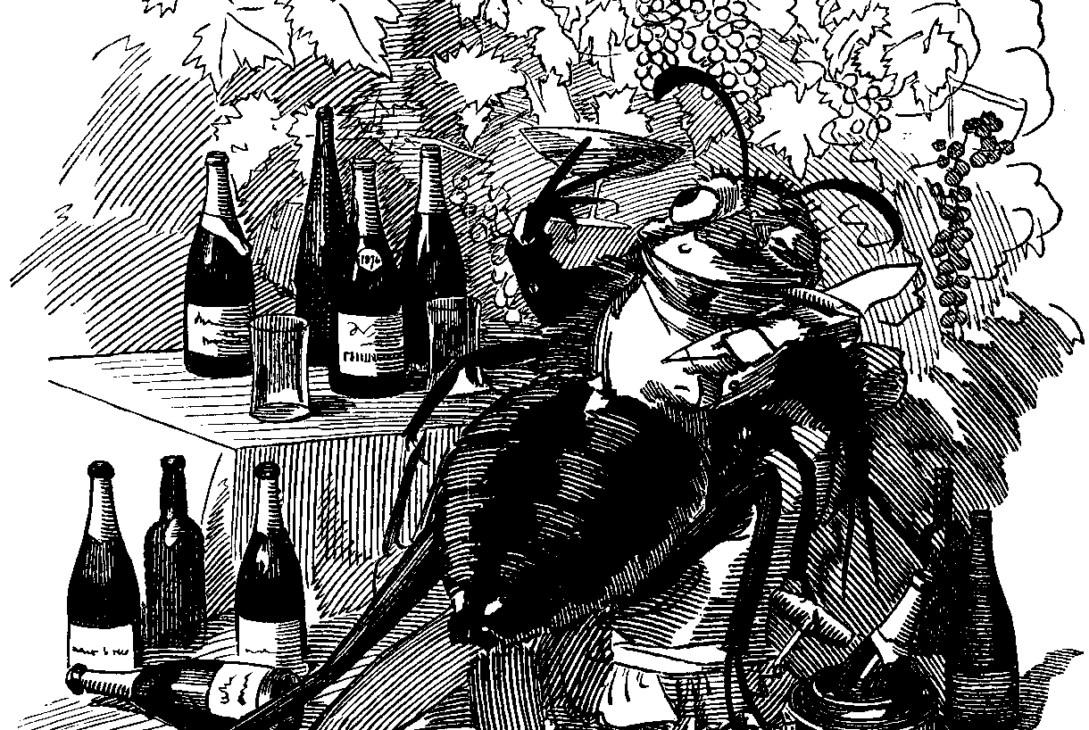It is rare today to find vines that have not been grafted to American rootstock to counter phylloxera, which destroyed so many of the world’s vines. Until recently, few people had any idea of how this had affected the wines’ flavours, but a few producers are now making wines from ungrafted vines and have discovered a taste of yesteryear, writes Kerin O’Keefe.
It is hard to believe that a nearly microscopic louse is responsible for obliterating age-old traditions of vine cultivation and wine production around the world. Yet phylloxera, a tiny insect which kills grape vines by attacking their roots, accomplished just that and continues to attack California and parts of the New World today.
Aptly named phylloxera vastatrix or ‘the devastator’ by 19th-century French scientists, the pest was unknowingly imported into Europe from America with live vines during the height of botanical imports from the New World. Destroying nearly 2.5 million ha (hectares) in France alone, phylloxera raged throughout Europe from the 1860s until the 1930s before being brought under control.
After much trial and error, it was discovered that the only effective solution was grafting the European vitis vinifera varietals onto resistant US rootstocks, a technique which still holds true today. While replanting grafted vines saved wine production from extinction in the Old World, experts and wine lovers have often wondered what wine was like before phylloxera. Thanks to tiny parcels of vineyards throughout Europe which were inexplicably unscathed by this voracious aphid – as well as a very few courageous producers who are risking all by planting ungrafted vines – it is still possible to get a taste of these wines from the past.
‘To talk about Vieilles Vignes Françaises, cultivated in the historic Champagne manner, is to fling oneself into the past and boldly confront the archetypal taste of Champagne,’ says Ghislain de Montgolfier, president and great-grandson of founder Jacques Bollinger, about his family’s legendary pre-phylloxera Champagne.
As well as being one of the rarest, most expensive Champagnes available, Vieilles Vignes Françaises is also an oenological phenomenon. For no obvious reason, three tiny parcels of ungrafted Pinot Noir escaped phylloxera.
‘No one knows why these tiny vineyards were not infected,’ explains general manager Hervé Augustin. ‘The two in Aÿ are surrounded by walls, as were many other vineyards destroyed by the blight. The Bouzy plot is surrounded by vineyards which were all devastated.’
The close proximity to the ground and the wild profusion of vines actually facilitated phylloxera’s feasting frenzy in Champagne, where the traditional layering technique once prevailed. Virtually all its vines were annihilated.
Yet the Bollinger family has kept the layering technique of cultivation in these vineyards whereby the vines grow freely and close to the ground without training. Each year they are pruned down and one small branch is buried which springs up to regenerate the next year.
According to Augustin, the fruit from these three surviving plots is noticeably different: ‘Our pre-phylloxera grapes are riper, rounder and more concentrated than the grafted Pinot Noir grapes.’
Wine from these ancient crus has been bottled separately since 1969 and only in exceptional years. The must is fermented in aged oak barrels to ensure no oak flavour is imparted to the wine and then bottled for its second fermentation and subsequent ageing with cork stoppers instead of the more common crown caps.
Since its debut, enthusiasts have been lauding the wine’s unusual qualities. The VVF is decidedly fuller bodied and richer than Champagne from grafted vines. The current release, 1996, from a vintage hailed as one of the best of the 20th century for Champagne, is opulent with an incredibly long finish of marrons glacés. If the Vieilles Vignes Françaises is a benchmark for what Champagne was like before phylloxera, then one gets a sense of the devastation this insect inflicted.
While Champagne has VVF, Oporto has Nacional, the rare vintage port from ungrafted vines grown on a small parcel in the heart of the Quinta do Noval estate. Again, no plausible reason exists why this plot survived while others succumbed, though managing director Christian Seely says: ‘The Nacional vineyard marches to a different drum from the rest of the vineyards.’ The current vines are up to
50 years old; when a plant dies, a cutting is taken from a Nacional vine and planted directly in the ground. The tiny production yields a port with an astonishingly rich, velvety concentration and ripe but refined fruit. According to Seely: ‘Nacional is a supreme example of the importance of terroir.’
Another vineyard untouched by the blight is the Lisini estate in Montalcino. Widely noted for its Brunello, Lisini also boasts a half-hectare vineyard of Sangiovese, with vines dating back to the mid-1800s, which inexplicably never succumbed to phylloxera.
According to cellar master Filippo Paoletti, ‘No one knows why this vineyard was never attacked, as it is no different from those that were destroyed. It is, however, about a kilometre away from the nearest vineyard and is surrounded by olive groves.’ When consultant oenologist Franco Bernabei first set eyes on the ancient vines there was no doubt in his mind what to do.
Lorenzo Lisini of the family estate recalls: ‘We used to use the pre-phylloxera grapes along with those from our other vineyards for Brunello. But Bernabei suggested that we make one wine from this vineyard to honour the rare vines, using traditional techniques.’ Since 1985 the winery has produced Prefillossero. The wine is aged for one to two years, depending on the vintage, in Slavonian oak. Further ageing takes place in large glass demijohns for another two years before it is bottle aged. The wine has devout followers, including Italian wine critic Luigi Veronelli, who inscribed on a bottle of the 1987, on show at the winery, that drinking Prefillossero was like listening to ‘the earth singing to the sky’.
The wine is complex and subtle, more elegant than powerful with a bouquet of balsamic herbs and violets and smooth tannins combined with sharp acidity. ‘Many people who try Prefillossero think it must have a lot of wood ageing because the wine is dominated not by fruit but by aromas and tastes usually associated with years in wood,’ says Paoletti. ‘But since it is predominantly aged in glass, this is the natural perfume and flavour from the grapes. American roots saved us but they also changed the taste of our wines. Before phylloxera, this was what wine was like.’
Further north, in Serralunga d’Alba, home to some of today’s most critically acclaimed Barolos, Teobaldo Cappellano has been quietly producing his Barolo Otin Fiorin Piè Franco since 1994 from ungrafted vine cuttings planted in 1989. Cappellano, an outspoken traditionalist and philosopher, who refuses to allow his wines to be rated numerically or be mentioned in wine guides, says he planted the ungrafted cuttings to satisfy his own curiosity. ‘Winemakers have long memories,’ he says, ‘and all my life I’ve had to listen to my grandfathers and other old-timers say: “Ah, but Barolo before phylloxera, that was real wine”.’
Inspired by both the nostalgia of these veteran winemakers, and by his own desire to produce Barolo that expresses the unadulterated characteristic of Nebbiolo through the Langhe terroir, Cappellano planted more than 1.5ha of ungrafted vines alongside his 60-year-old grafted Nebbiolo. To offer some measure of protection he also planted three rows of grafted Nebbiolo on all sides of the vulnerable Piè Franco vines. The results, both in the vineyard and in the final product, have surprised Cappellano.
‘The ungrafted vines produce about 50% fewer grapes than their grafted counterparts. While phylloxera was a reality, a lot of small peasant growers at the time accused larger growers of wanting to replant with higher yielding grafts to increase quantity. They may not have been wrong.’ Side by side in the same vineyard, it is easy to see which vines are ungrafted. The Piè Franco vines on their original rootstocks are notably sparser when compared with the lush vines grafted on American rootstocks.
A true comparison
Comparing the two Barolos from the same vineyard and vintage demonstrates their different personalities. The 1998 Barolo from the ungrafted vines is like a Fellini film: difficult to understand at first but immensely enjoyable once you do. Its intense nose of rose petals, clove and orange peel is far more persistent than that of its grafted counterpart, with its more recognisable perfume of ripe fruit and rose. The ‘pre-phylloxera’ Barolo is also more austere, with tannins that will take years to soften, and seems destined to withstand marathon ageing. The Barolo from grafted American rootstock shows ripe fruit and is already enjoyable although it too will benefit from a few years in the cellar. But what if the dreaded louse should someday attack? ‘At least I’ll be able to say that I’ve had fun,’ says Cappellano with a grin.
Spain’s elite Ribera del Duero producer Vega Sicilia recently released Pintia, from Bodegas Pintia in Toro, from ungrafted Tinta de Toro (Tempanillo) vines. Most of the vineyards here survived phylloxera thanks to a predominantly sandy soil – a natural obstacle to the parasite. ‘We consider the wines produced with grapes from such pre-phylloxera vines as better expressions of the varietal’s true character,’ says the company’s Rafael Alonso, adding that Pintia is rustic but elegant with an unusually intense colour.
Almost 150 years since the aphid was first detected in Europe, science has found few ways to combat phylloxera, and grafting remains the only known protection. Yet even grafting is not always effective. As Christy Campbell points out in his book, Phylloxera: How Wine was Saved for the World, California, which was first attacked at about the same time as Europe, is suffering its second invasion. European varietals grafted on certain species of rootstock believed resistant have since proven susceptible. Since the mid-1980s thousands of hectares have been destroyed and are being replanted with more resistant rootstock. Parts of Australia and New Zealand – where for years producers planted ungrafted vines – have also been attacked.
The one safe haven for ungrafted European vines? Chile, protected on all sides by natural barriers afforded by the Andes Mountains, the Pacific Ocean and the Atacama Desert, has never seen a trace of the dreaded parasite.
Originally published here: The Great Escape
Bollinger Vieilles Vignes Française Cappellano Decanter Lisini phylloxera Piè Franco pre-phylloxera Prefilossero Quinta do Noval Nacional Teobaldo Cappellano ungrafted vines Vega Sicilia Pinta
Last modified: December 21, 2023



